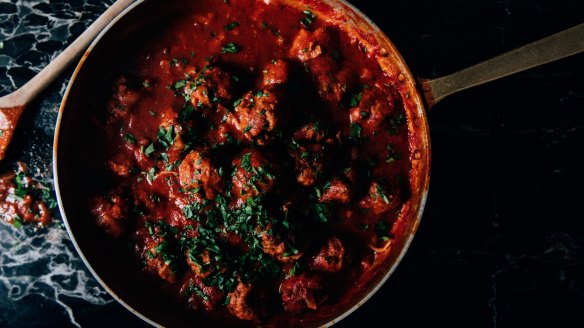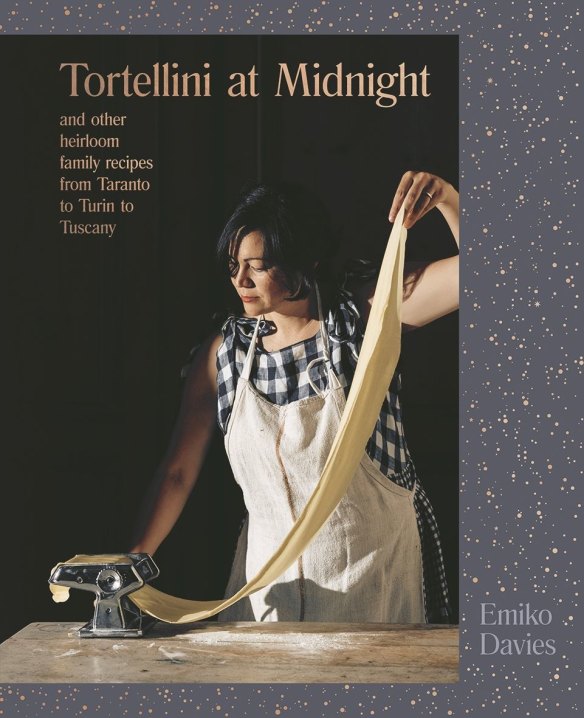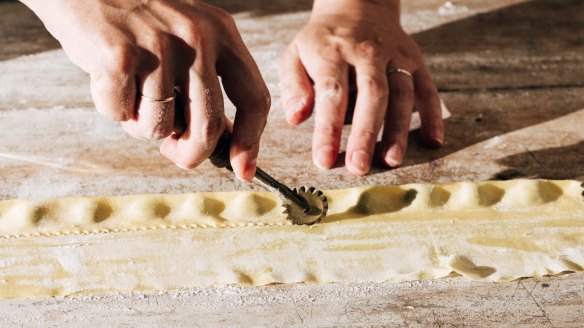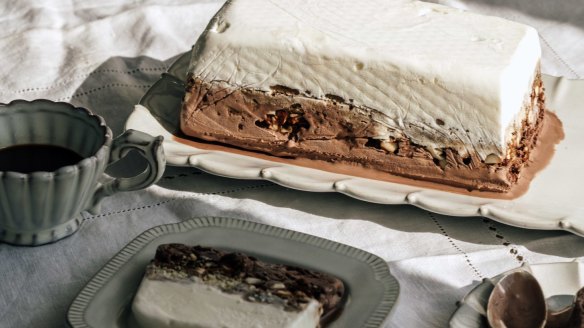Tortellini at Midnight: Make a two-course meal from meatballs

Pasta with broccoli was the first dish Emiko Davies ever cooked for her Italian husband Marco. They didn't know each other very well, still nervous about what the other person thought. It was late on a cold miserable Florence night and she threw together an impromptu meal for a surprised and hungry young man.
All she had in the fridge of her tiny apartment was a small head of broccoli, a piece of pecorino, some garlic.
After he took his first bite he turned to Davies and said ti sposerò "I'm going to marry you" and two and a half years later he did.

They say the way to a man's heart is through his stomach, but this relationship connected Davies, Australian-born with a Japanese mother and Australian father, with generations of Italian cooking.
In her new book Tortellini at Midnight she shares wonderful stories and some of her favourite recipes from her Italian family, recipes she learned through tasting and watching, usually from the kitchen table.
Davies, who used to write for The Canberra Times, has published three cookbooks.
Karen Hardy
Polpette di Nonna Anna (Nonna Anna's meatballs)
The best part of this recipe is perhaps the sauce, richly flavoured with pancetta and the polpette themselves, which is used to dress pasta to be eaten as the first course. The rest of the polpette are served as the main dish, along with roasted potatoes and a crisp salad. It is, like so many dishes in the Puliege tradition, a perfect two-course meal.
INGREDIENTS
700g minced beef
300g minced pork
2 eggs
50g parmesan, grated
50g dry breadcrumbs
2 tablespoons finely chopped fresh flat-leaf parsley, plus extra to serve
1 tsp salt, plus extra to taste
60ml extra-virgin olive oil
1 large onion, halved and sliced
80g pancetta or rigatino, finely sliced
700g tomato passata
METHOD
1. Combine the beef, pork, eggs, parmesan, breadcrumbs, parsley, salt and some freshly ground black pepper in a large bowl. Mix very well – using your hands is best – until you have a firm, well-amalgamated mixture. Shape into balls a little larger than golf balls. Set aside on a plate.
2. Heat the olive oil over a medium–high heat in a deep casserole pot. Sear the polpette in batches, for about 2 minutes each side, until they are lightly browned. (You don’t need to cook them through; just colour them.) Once the meatballs are browned, reduce the heat to low and gently fry the onion slices and pancetta for about 7 minutes, or until the onion is softened and the pancetta melts and begins to crisp slightly.
3. Return the meatballs to the pot. Add the passata, along with 250ml water. Season the sauce with salt and pepper and bring to a simmer over a low–medium heat. Cover and cook for 25 minutes, stirring occasionally. Uncover and cook for a further 15 minutes, or until the sauce has reduced to a rich, thick consistency.
4. Serve the polpette as is, with plenty of sauce, together with roasted potatoes and a crisp green salad, or set aside the meatballs separately (keeping them warm) and toss your favourite pasta, cooked al dente, through the sauce. Serve this as the first course with some parmesan and parsley, then serve the meatballs as the main.
Serves 6-8

Handmade pasta filled with roasted meat (Agnolotti al plin)
As you move across the Piedmonte landscape, the shape of agnolotti change from small rectangles, similar to regular ravioli, to plin, dialect for pizzicotto (pinch), which are smaller and are named for the pinch that encloses the filling in the pasta. Their special plin shape results in little pockets that are perfect for holding the sauce, which is often simply the leftovers found in the bottom of the pan where the meat was roasted, or some melted butter and parmesan.
INGREDIENTS
Filling
300g beef and/or pork, cut into large chunks
2 tbsp olive oil
1 garlic clove
1 sprig rosemary
125ml white or red wine
250ml meat or vegetable stock (or water)
80g baby spinach (see note)
80g butter
30g parmesan, finely grated, plus extra to serve
2 egg whites, or as needed (save the yolks for the pasta)
freshly grated nutmeg
fresh sage leaves
Pasta
200g plain flour, plus extra for dusting
160g egg yolks (about nine; save some of the egg whites for the filling and brushing)
semola (durum wheat flour) or extra plain flour, for dusting
METHOD
1. To prepare the filling, sprinkle salt and pepper over the meat. Place the olive oil, garlic and rosemary in a casserole pot and heat gently over a low heat to infuse the oil, about 5 minutes. Add the meat chunks, increase the heat to high and lightly brown them on all sides for about 5 minutes. Pour over the wine and, keeping the heat on high, bring it to a rapid simmer and cook for about 10 minutes, or until the wine has reduced significantly. Pour in the stock, lower the heat to low-medium and bring to a simmer. Cook, covered, for 15 minutes, then uncover and continue cooking for a further 15 minutes. The meat should be tender and there should be some delicious pan juices to conserve for the sauce. Set aside, separating the meat from the juices.
2. In a separate frying pan, wilt the spinach with about 30g of the butter and a good pinch of salt, about 2 minutes.
3. To finish the filling, chop the meat into smaller pieces, then place in a food processor along with the spinach and parmesan. Blend until you have a very fine mixture. Add the two egg whites and blend again until you have a soft paste – you can add more egg white as needed to get the right consistency. Add a grating of nutmeg and freshly ground black pepper. Set aside while you make and roll out the pasta.
4. For the pasta, sift the flour into a large mixing bowl and make a well in the middle. Tip in the yolks (save the egg whites; you will need at least one for brushing the pasta) and, using a fork, begin beating the eggs, incorporating the flour around them. Keep working this way until you have a sticky, thick mixture and mixing with a fork becomes difficult. Transfer the sticky dough to a wooden board, along with any flour remaining in the bowl and, using your hands, begin kneading the dough, incorporating the remaining flour bit by bit. The reason you are doing it bit by bit is because you may not need all the flour or you may need it all plus more – but, either way, going slowly allows the flour to absorb the liquid better, giving you a better idea of how much or how little flour to use.
3. Once you have a very firm, smooth (not sticky) dough, cover it in plastic wrap, or place in a bowl covered with a damp tea towel (dish towel) and set the dough aside for 30 minutes.
4. The dough should now be very smooth and elastic. If you find it has become slightly tacky, dust it very lightly with some more flour. Divide the dough into four even pieces and work one piece at a time, keeping the others covered. Pass the dough through a pasta machine, starting with the widest setting and bringing it to the thinnest.
5. Lay the first sheet of dough on a work surface (wood is best; marble or stone tend to encourage sticking) lightly dusted with flour. Divide in half lengthways so that you have two long pieces, about 6cm-7cm wide. Place half teaspoons of filling (about the size of a hazelnut), no more than 2cm away from each other, and about 1.5cm-2cm from the long edge.
6. Brush some of the leftover egg white along the wider side of the pasta sheet right up against the filling. Fold over the pasta from the edge towards the middle, extending 1cm-1.5cm past the filling (so you are essentially covering and rolling the filling towards the middle slightly). Pinch the pasta together perpendicular to the work surface between each ball of filling, ensuring there is no trapped air. Trim the long edge of the pasta with a frilled pastry cutter, leaving a 1cm wide flap from the filling.
7. Now, with the frilled pastry cutter, cut decisively between each "pinch" (it’s best to do this from the pinch towards the flap, turning so you are cutting away from you), letting the agnolotti roll over as you cut each piece – this action will help seal the "pocket" (and, if they don’t seal entirely, you can pinch them again individually. You should have little parcels about 3cm long by 1.5cm thick.
8. Place the finished agnolotti on a surface well dusted with semola and continue making them until the pasta is used up.
9. Bring a large pot of salted water to the boil.
10. In the meantime, heat the reserved pan juices in a wide frying pan along with the rest of the butter and a few sage leaves. Warm until the butter is melted and the sauce is thick – reduce slightly if it is too liquid, or add a splash of the pasta cooking water if it is not loose enough. Taste for seasoning and add salt and pepper if needed.
11. Boil the agnolotti for about 3 minutes, then drain. Serve them immediately, with a few spoonfuls of the sugo di arrosto (pan juices) drizzled over the top and grated parmesan on the side.
Serves 4
Note: Both the filling and the pasta can be prepared the day before you want to make the angolotti. You can use any meat for the filling. Instead of the spinach, cabbage, any wild weeds or even escarole salad, which has a slightly bitter flavour, are commonly used. Tougher leaves such as cabbage will have to be blanched for a few minutes in boiling water before using.

Spumone (ice-cream cake)
This recipe is a breeze whether made from scratch with the help of an ice-cream machine or with your favourite store-bought gelato. I've opted for fior di latte (milk) and chocolate gelato - family favourites - with an inner layer of savoiardi dipped in coffee (you can use milk for kids or add a splash of rum if it's for adults only) and crushed almond brittle. If making it with store-bought gelato, you'll need to remember to take the gelato out of the freezer to soften slightly before spreading into layers. Feel free to add your own variations - other than gelato flavours, you may like to use different nuts for the brittle, stir the crushed brittle into the gelato, or use chopped chocolate, candied fruit or anything else that takes your fancy.
INGREDIENTS
50g savoiardi biscuits
60ml espresso coffee (or milk), cooled
Gelato
1 litre full-cream milk
200g sugar
100g 70 per cent dark chocolate, roughly chopped
30g bittersweet cocoa powder
250ml pouring cream
Cupeta
100g whole, raw almonds
60g sugar
METHOD
1. For the gelato, place the milk and sugar in a saucepan and heat until it is almost boiling (but watch it carefully; you mustn’t let it boil). You should find the sugar has dissolved and the surface of the milk is frothy. Remove from the heat and pour half of the milk into a container.
2. To the milk left in the saucepan (while it is still hot), add the chocolate and cocoa and whisk until smooth. Let it cool, then chill it in the fridge.
3. With the container of milk and sugar, leave it to cool completely, then add the cream and chill it in the fridge.
4. Churn the fior di latte (milk) gelato in an ice-cream machine according to the manufacturer’s instructions. You may need to clean and let the ice-cream machine re-freeze in the freezer before doing the chocolate gelato, but check the instructions.
5. While the gelato is still soft, pour it into a loaf tin lined with plastic wrap and smooth it out with a spatula. Cover with plastic wrap and place it in the freezer to harden for a few hours or overnight.
6. Churn the chocolate gelato in the ice-cream machine until soft and creamy.
7. Meanwhile, make the cupeta. Place the almonds, sugar and 1 tablespoon water in a single layer in the bottom of a frying pan set over a medium heat. Cook until the sugar begins to melt and turn caramel brown. Shake the pan occasionally as the sugar melts, then toss the almonds with the caramel until toasted and well coated. Altogether, this process may only take about 5 minutes. Pour the mixture onto a baking sheet or chopping board lined with baking paper and leave to cool. Before it is completely cool and hardened, chop finely with a heavy knife.
8. Dip the savoiardi biscuits into the coffee (or milk) and place a layer of them evenly over the fior di latte gelato in the loaf tin. Sprinkle over the chopped cupeta, then smooth over the softened, just-churned chocolate gelato right to the top.
9. Cover with plastic wrap and freeze until the chocolate gelato has hardened, preferably overnight. Turn out the spumone onto a flat serving plate, remove the plastic wrap and cut thick slices with the help of a large knife dipped in hot water.
Serves 6-8
This is an edited extract from Tortellini at Midnight by Emiko Davies, available from March 1, Hardie Grant Books, $52.
The best recipes from Australia's leading chefs straight to your inbox.
Sign up